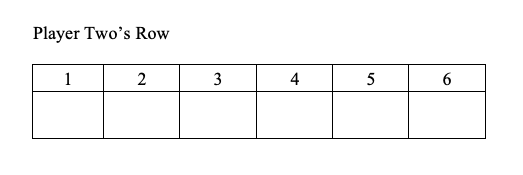Beginning Activity The Game of Dodge Ball
(From The Heart of Mathematics: An Invitation to Effective Thinking by Edward B. Burger and Michael Starbird, Key Publishing Company, © 2000 by Edward B. Burger and Michael Starbird.)
Dodge Ball is a game for two players. It is played on a game board such as the one shown in Figure 9.24 and Figure 9.25.


Player One has a 6 by 6 array to complete and Player Two has a 1 by 6 row to complete. Each player has six turns as described next.
Player One begins by filling in the first horizontal row of his or her table with a sequence of six X's and O's, one in each square in the first row.
Then Player Two places either an X or an O in the first box of his or her row. At this point, Player One has completed the first row and Player Two has filled in the first box of his or her row with one letter.
The game continues with Player One completing a row with six letters (X's and O's), one in each box of the next row followed by Player Two writing one letter (an X or an O) in the next box of his or her row. The game is completed when Player One has completed all six rows and Player Two has completed all six boxes in his or her row.
Player One wins if any horizontal row in the 6 by 6 array is identical to the row that Player Two created. (Player One matches Player Two.)
Player Two wins if Player Two's row of six letters is different than each of the six rows produced by Player One. (Player Two “dodges” Player One.)
There is a winning strategy for one of the two players. This means that there is plan by which one of the two players will always win. Which player has a winning strategy? Carefully describe this winning strategy.
Applying the Winning Strategy to Lists of Real Numbers.
Following is a list of real numbers between 0 and 1. Each real number is written as a decimal number.
Use a method similar to the winning strategy in the game of Dodge Ball to write a real number (in decimal form) between 0 and 1 that is not in this list of 10 numbers.
1.
Do you think your method could be used for any list of 10 real numbers between 0 and 1 if the goal is to write a real number between 0 and 1 that is not in the list?
2.
Do you think this method could be extended to a list of 20 different real numbers? To a list of 50 different real numbers?
3.
Do you think this method could be extended to a countably infinite list of real numbers?